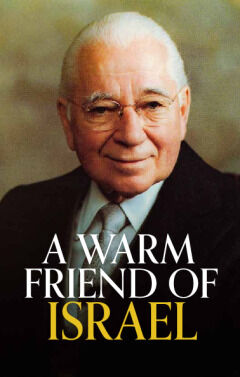
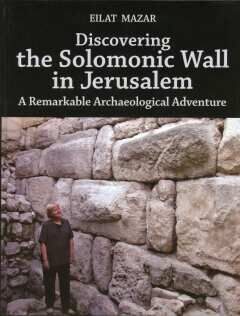
Discovering the Solomonic Wall in Jerusalem—A Remarkable Archaeological Adventure
In this charming, informative, scholarly, yet understandable book, Hebrew University archaeologist Eilat Mazar, who previously uncovered what may be King David’s palace, continues the excavations of her famous grandfather, Professor Benjamin Mazar, at the southern wall of Jerusalem’s Temple Mount. Combining youthful memories of her grandfather with her own most recent excavations, she explores the southern gate of biblical Jerusalem and discovers the city wall built by King Solomon.
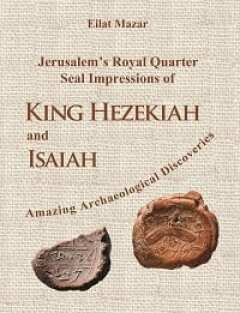
Jerusalem’s Royal Quarter Seal Impressions of King Hezekiah and Isaiah—Amazing Archaeological Discoveries
The amazing discovery of King Hezekiah’s seal impression, and perhaps also of the one belonging to the Prophet Isaiah, is described in detail in this publication. This is a first-hand account of the excavator who revealed these unique finds within Jerusalem’s Royal Quarter dating back to the First Temple period. King Hezekiah’s seal impression is the most personal and closest find related to an Israelite or Judean king ever found in scientific archaeological excavations. Not only does this seal impression belong to the greatest Judean king after King David, but, also, clearly states his name, his father’s name, and his title as “King of Judah,” along with the royal symbols chosen by the king himself.
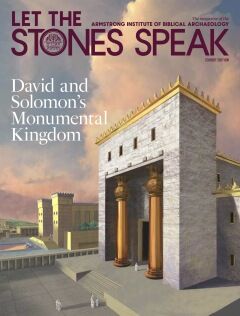
Let the Stones Speak, Exhibit Edition 2024
Discovering the archaeological evidence for the kingdom of David and Solomon
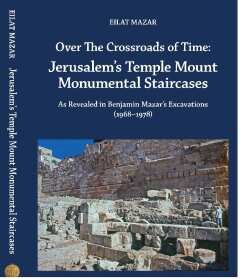
Over The Crossroads of Time: Jerusalem’s Temple Mount Monumental Staircases
Two thousand years ago, King Herod constructed a tremendous compound on the Temple Mount in Jerusalem, in which he built the Temple and the Royal Stoa—marvels of classical architecture for their size, might, and beauty. The Temple and the Royal Stoa were diametrical opposites. The realm of the sacred was the very essence of the Temple, while the Royal Stoa represented the secular. Accordingly, separate access routes were built to these mutually exclusive spheres, while raising the construction techniques of his time to new and unparalleled levels of sophistication. The archaeological excavations that Professor Benjamin Mazar conducted at the foot of the Temple Mount walls during the entire decade between 1968 and 1978 uncovered the immense crossroads built by Herod that had been used by the thousands of pilgrims and visitors to the Temple Mount without fear of mingling the consecrated with the commonplace. The archaeologist Eilat Mazar (Benjamin’s granddaughter) has written the detailed story of those excavations and the surprising conclusions to be drawn from them. Over the Crossroads of Time: Jerusalem’s Temple Mount Monumental Staircases tells that story—based on the groundbreaking excavations conducted by Benjamin Mazar and the rich data they produced, along with explanations based on rigorous scientific research, accompanied by hundreds of photographs and illustrations, as well as 3D reconstructions. Dr. Eilat Mazar has been conducting excavations in the Ophel and the City of David areas of Jerusalem for four decades, to uncover the city’s ancient past. She has written numerous books about ancient Jerusalem, including The Complete Guide to the Temple Mount Excavations and the monumental work The Walls of the Temple Mount.
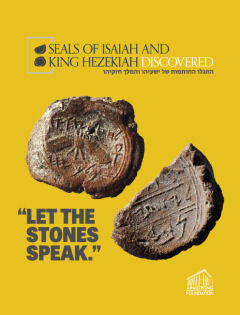
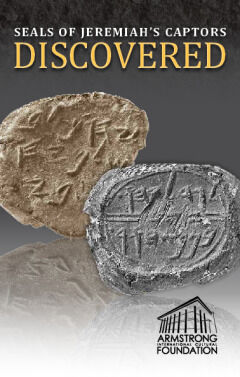
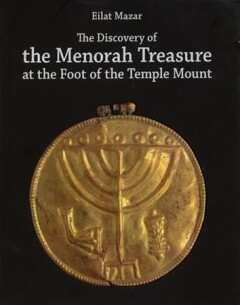
The Discovery of the Menorah Treasure at the Foot of the Temple Mount
The recent discovery of a 1,400-year-old golden treasure trove, which sheds new light on a relatively unknown period in the history of Jewish Jerusalem. The finding was made during an archeological excavation near the foot of Temple Mount in the Old City of Jerusalem, and is linked to the Jewish settlement in the city during a short period of Persian rule in the early seventh century c.e. Hebrew University archaeologist Dr. Eilat Mazar disclosed the contents of the discovery : Two bundles containing thirty-six gold coins, gold and silver jewelry, and a gold medallion, ten centimeter in diameter, adorned with images of a menorah, (Temple candelabrum) a shofar, (ram’s horn) and a Torah scroll.
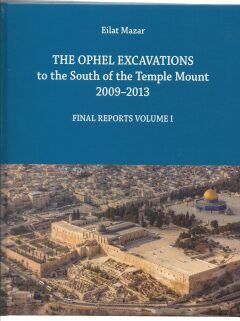
The Ophel Excavations to the South of the Temple Mount 2009-2013; Final Reports Volume I
This volume, the first in a multi-volume series of the final reports of the renewed excavations’ results, includes the final report of the Byzantine (4th-7th centuries c.e.). Architectural remains unearthed at the Ophel, with a description of their layout adaptation to satisfy the needs of the large and growing number of pilgrims that arrived in Jerusalem. The city has become increasingly important for Christians, including the pottery and coin assemblages found within. This book contains a full account of the incredible discovery of the Byzantine Gold and Silver Menorah Treasure, representing the last evidence of activity in the eastern part of the Ophel until modern times. The volume also includes reports on the impressive remains of First Temple Period buildings unearthed at the Ophel’s Solomonic Royal Quarter (10th century b.c.e.). Together with the large amount of glyptic finds, weaponry, cultic objects, ivories and figurines discovered within them, all attesting to the far reaching international contacts Jerusalem enjoyed at that time. The last chapter of this volume presents a unique find belonging to King Hezekiah (8th century b.c.e.) found for the first time in a scientific archaeological excavation. These finds dramatically alter previously held conceptions of the development of ancient Jerusalem and provide striking tangible evidence for its Biblical narratives.
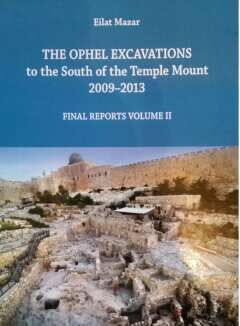
The Ophel Excavations to the South of the Temple Mount 2009-2013; Final Reports Volume II
From 2009 to 2013 renewed archaeological excavations were carried out at the Ophel under the directorship of Dr. Eilat Mazar on behalf of the Hebrew University of Jerusalem. This volume, the second in the multi-volume series of the renewed excavations’ final reports, includes the report of the Herodian (First century C.E.) buildings, many of which were planned to satisfy the needs of the large and growing number of pilgrims that arrived at the magnified newly constructed Temple and its breathtaking compound. These buildings, crowdedly built in the Ophel, included a large number of Purification Baths (Mikva’ot), ranging from single- sized baths to the “Jerusalemite” type, where a multitude of pilgrims could immerse at the same time, thus enabling easy access to the nearby gates and their underground passageway directly leading into the sacred area of the Temple. By the end of the Second Temple period, as stated by Josephus, the Ophel area also served as a hiding place for the rebels against Rome, and this is corroborated by the findings within the buildings unearthed during the excavations. The volume also includes reports on the impressive remains of First Temple Period buildings discovered at the Ophel’s Solomonic Royal Quarter, together with a large amount of pottery vessels, glyptic finds, weaponry, cultic objects, ivories and figurines discovered within them, many of which attest to the far-reaching international contacts Jerusalem enjoyed at that time. This volume includes the report of the unique Fortified Enclosure, the earliest structure ever found in the Ophel, dating from the time of King David (early tenth century B.C.E) and most likely identified with the “Par House,” a structure he used while escaping from Avshalom (2 Samuel 15:17). This volume also includes the report of a stratified assemblage dumped from the Building of the Royal Bakers, which included the bulla (seal impression) of King Hezekiah himself, and maybe also the bulla of the prophet Isaiah, as well as dozens of finds found with them. The Ophel discoveries dramatically alter previously held conceptions of the development of ancient Jerusalem and provide striking tangible evidence for its Biblical and Second Temple period narratives,
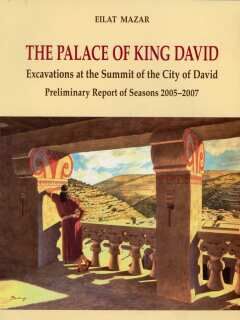
The Palace of King David—Excavations at the Summit of the City of David; Preliminary Report of Seasons 2005-2007
The historical description in ii Samuel 5 of David and his Phoenician allies – those reputable builders who constructed his new palace – is immeasurably well suited to the archaeological facts uncovered in the excavations of the Large Stone Structure. The construction of the Palace, as a monumental extramural construction enterprise, accords well with David’s vision of a city to be expanded northward, onto Mount Moriah, where he planned to build the temple. The preliminary report of the excavations at the summit of the City of David hill is 2005- 2007 summarizes the main findings from the Chalcolithic (the fifth millennium b.c.e.) through the Early Islamic (the 11th century c.e.) periods and presents initial conclusions of great importance to the study of the ancient history of Jerusalem.
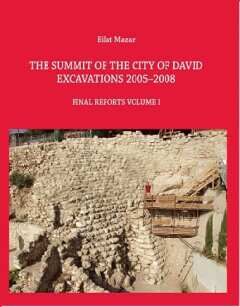
The Summit of the City of David Excavations 2005-2008; Final Reports Volume I
From 2005 to 2008 archaeological excavations were carried out at the summit of the City of David under the directorship of Dr. Eilat Mazar on behalf of the Hebrew University of Jerusalem. The excavations were conducted in the area of the City of David Archeological Park visitor’s center, managed by the Ir David Foundation. Unearthed were the impressive remains of fortifications and a massive royal structure, as well as large amounts of pottery, bullae, seals, ivories, figurines and arrowheads. The finds range in date from the beginning of the Iron Age II (the 10th century b.c.e.) until the Early Islamic period (the 11th century c.e.). This volume is the first in a series of final reports of the excavations at the summit of the City of David. It presents the architectural remains of the Stepped Stone Structure of the palace of King David, built by the Phoenicians in the 10th century b.c.e.; the collapse of a structure destroyed by the Babylonians in 586 b.c.e. and the poor construction built on top of it immediately following its destruction; a section of Nehemiah’s city wall, including the Northern Tower, erected in the fifth century b.c.e.; and the Persian, Babylonian and Iron Age ii layers sealed beneath it, one on top of the other. These findings have dramatically altered previously held conceptions of the development of ancient Jerusalem and provide striking tangible evidence for its Biblical narratives.
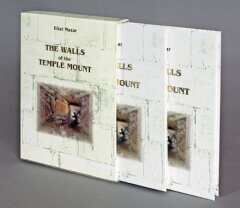
The Walls of the Temple Mount
This new colorful, oversized two-volume work is not only unusual; it’s extraordinary! It records every stone in the walls of Jerusalem’s holiest site, the Temple Mount, and explains their significance—the gates, the arches, the secret passages, the sealed-up entrances, the underground tunnels and more. It documents the history of the site’s construction—from the eastern wall in the First Temple Period to the renovations and additions to the south and east by Herod the Great in the Second Temple Period. Volume ii consists of large, colorful, remarkably detailed drawings and plans. This elegant, beautifully crafted boxed set is a perfect gift for that special someone with an interest in history or for your favorite school, church, synagogue or library.